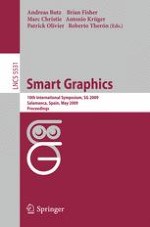2009 | Buch
Smart Graphics
10th International Symposium, SG 2009, Salamanca, Spain, May 28-30, 2009. Proceedings
herausgegeben von: Andreas Butz, Brian Fisher, Marc Christie, Antonio Krüger, Patrick Olivier, Roberto Therón
Verlag: Springer Berlin Heidelberg
Buchreihe : Lecture Notes in Computer Science
